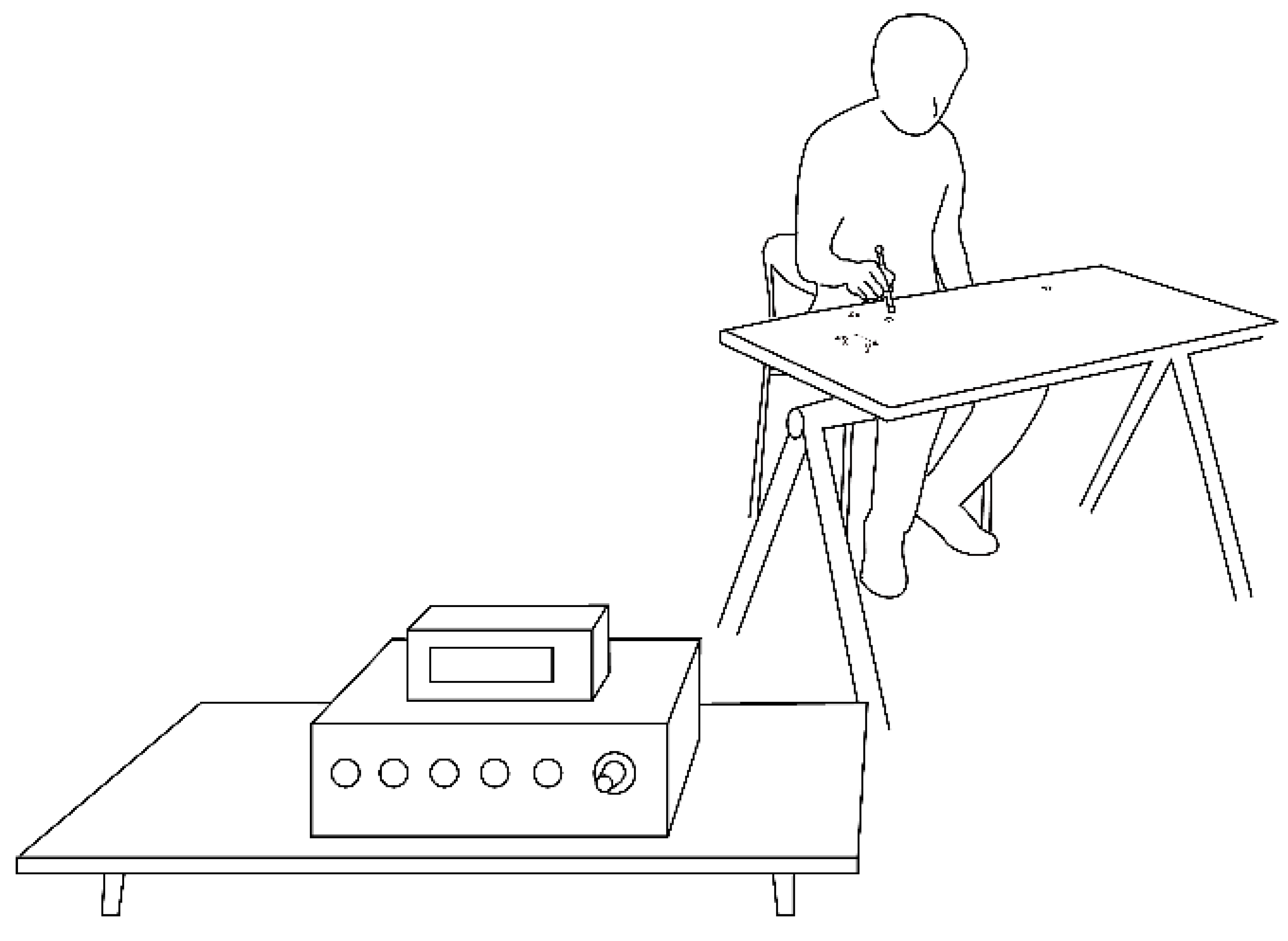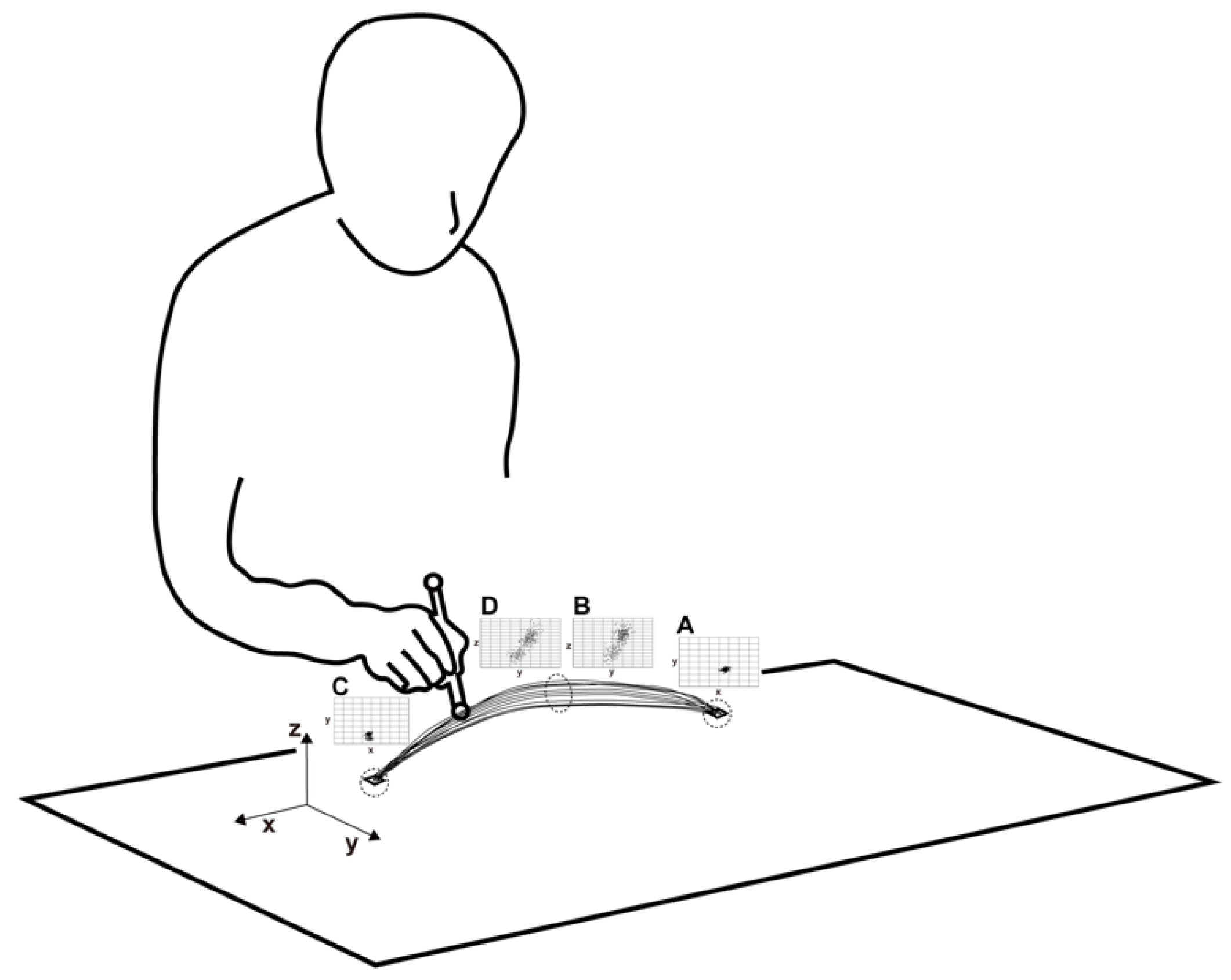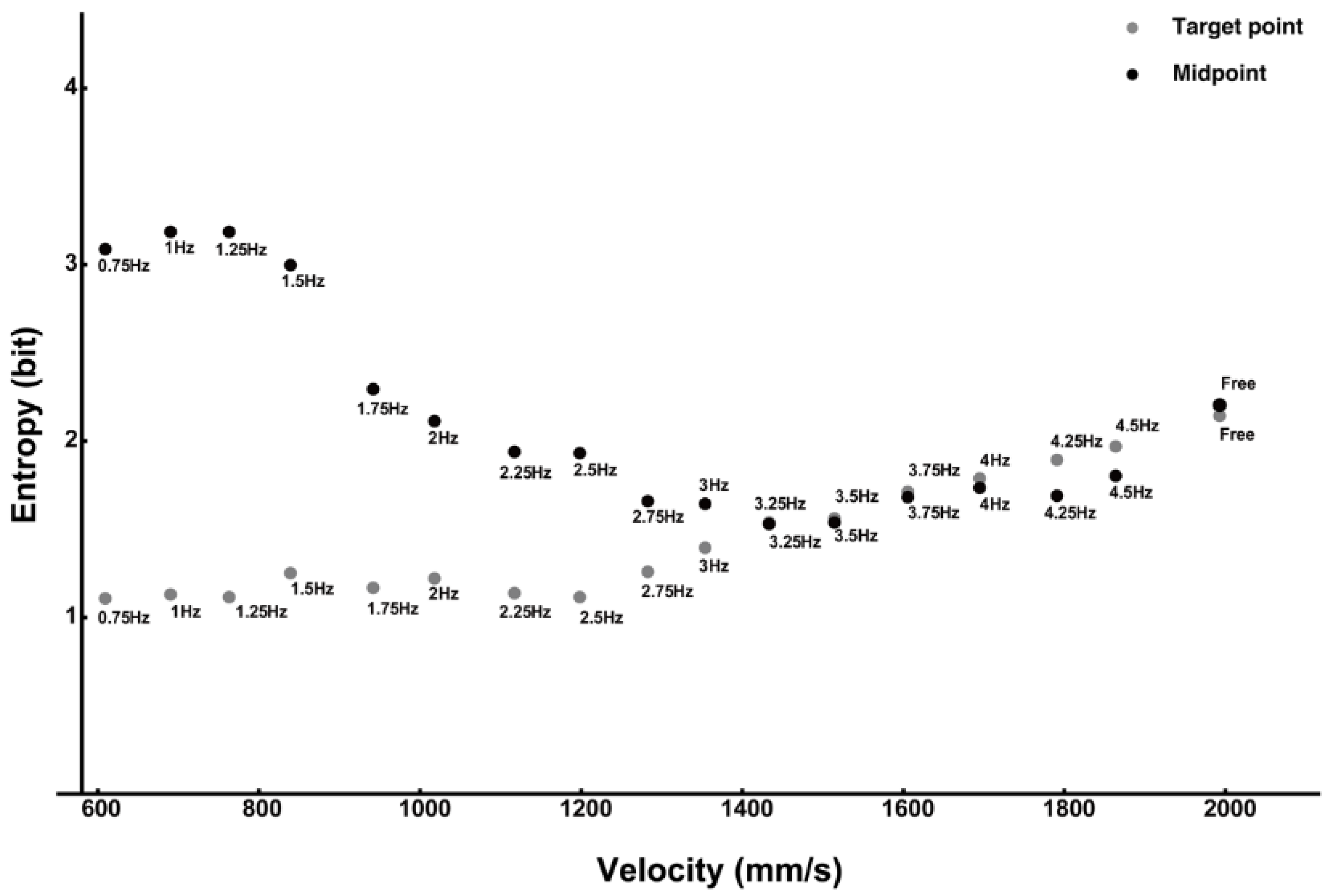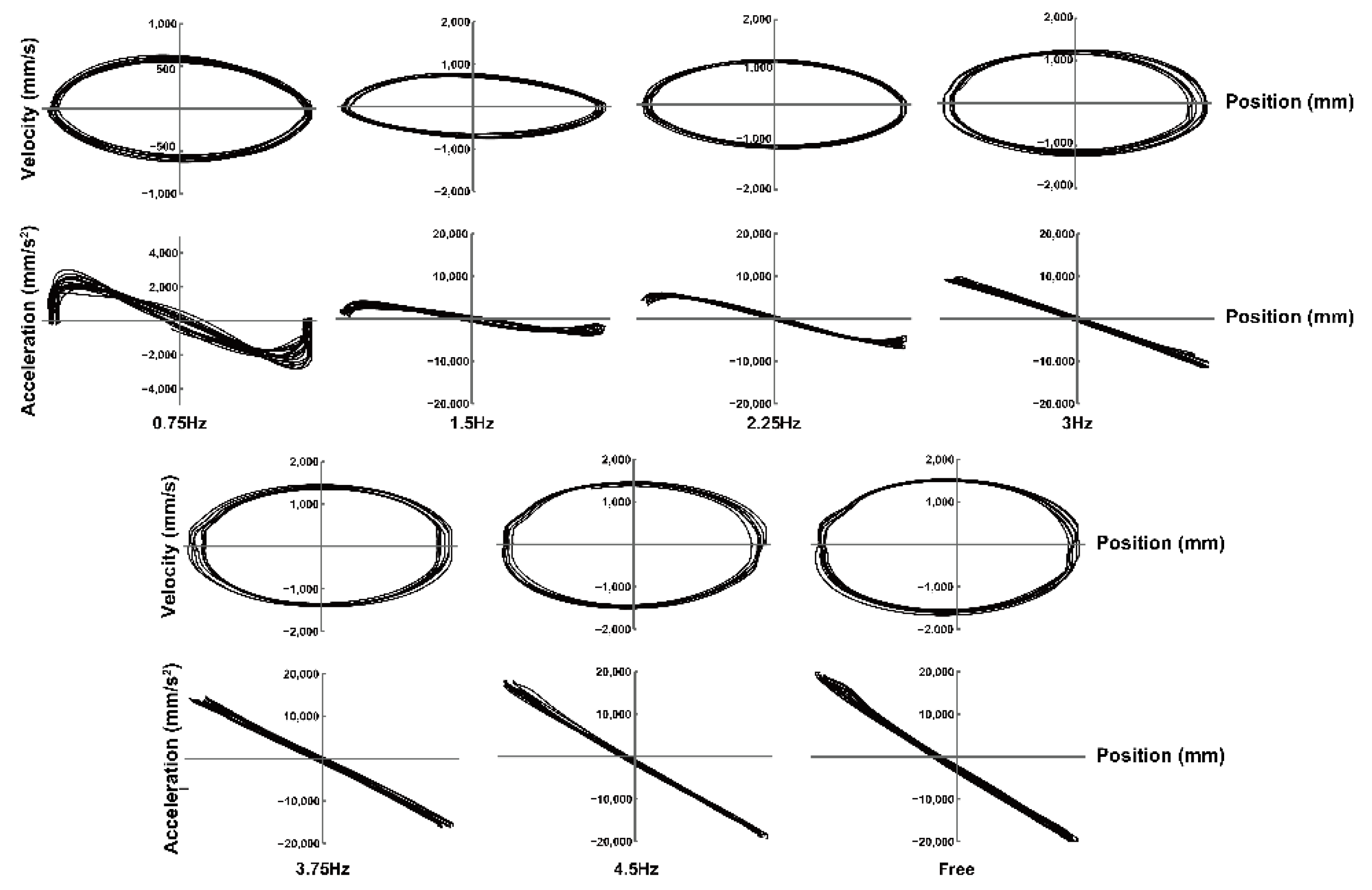Human Information Processing of the Speed of Various Movements Estimated Based on Trajectory Change
Abstract
:1. Introduction
2. Materials and Methods
2.1. Participant
2.2. Apparatus
2.3. Experimental Design
2.4. Experimental Procedure
2.5. Data Analysis
2.5.1. Movement Frequency
2.5.2. Movement Velocity and Acceleration
2.5.3. Error (Distance) from Target Center Point
2.5.4. Information Entropy
2.5.5. Mutual Information
2.6. Statistical Analysis
3. Results
3.1. Movement Frequency and Velocity
3.2. Error (Distance) from Target Center Point
3.3. Information Entropy and Relative Mutual Information
4. Discussion
Relation between Changes in Information Processing Points and Motor Control
5. Conclusions
Author Contributions
Funding
Institutional Review Board Statement
Data Availability Statement
Conflicts of Interest
References
- Fitts, P.M.; Posner, M.I. Human Performance; Brooks/Cole: Belmont, CA, USA, 1967. [Google Scholar]
- Woodworth, R.S. Accuracy of Voluntary Movement. Psychol. Rev. 1899, 3, 1–114. [Google Scholar]
- Fitts, P.M. The information capacity of the human motor system in controlling the amplitude of movement. J. Exp. Psychol. 1954, 47, 381–391. [Google Scholar] [CrossRef] [PubMed]
- Fitts, P.M.; Peterson, J.R. Information capacity of discrete motor responses. J. Exp. Psychol. 1964, 67, 103–112. [Google Scholar] [CrossRef]
- Shannon, C.E.; Weaver, W. The Mathematical Theory of Communication; The University of Illinois Press: Urbana, IL, USA, 1949. [Google Scholar]
- Hartley, R.V. Transmission of Information. Bell System Tech. J. 1928, 7, 535–563. [Google Scholar] [CrossRef]
- Miller, G.A.; Frick, F.C. Statistical behavioristics and sequences of responses. Psychol. Rev. 1949, 56, 311. [Google Scholar] [CrossRef]
- Hick, W.E. On the rate of gain of information. Q. J. Exp. Psychol. 1952, 4, 11–26. [Google Scholar] [CrossRef]
- Hyman, R. Stimulus information as a determinant of reaction time. J. Exp. Psychol. 1953, 45, 188. [Google Scholar] [CrossRef] [PubMed]
- Schmidt, R.A. Motor Control and Learning: A Behavioral Emphasis, 2nd ed.; Human Kinetics: Champaign, IL, USA, 1988. [Google Scholar]
- Bertucco, M.; Cesari, P.; Latash, M.L. Fitts’ Law in Early Postural Adjustments. Neuroscience 2013, 231, 61–69. [Google Scholar] [CrossRef]
- Gorniak, S.L. The Relationship between Task Difficulty and Motor Performance Complexity. Atten. Percept. Psychophys. 2018, 81, 12–19. [Google Scholar] [CrossRef]
- Murakami, H.; Yamada, N. Fitts’ Law When Errors Are Not Allowed: Quantification of Reciprocating Trajectories and Estimating Information Processing. Acta Psychol. 2021, 220, 103418. [Google Scholar] [CrossRef] [PubMed]
- Murakami, H.; Yamada, N. Estimating information processing of human fast continuous tapping from trajectories. Entropy 2022, 24, 788. [Google Scholar] [CrossRef] [PubMed]
- Raket, L.L.; Grimme, B.; Schöner, G.; Igel, C.; Markussen, B. Separating Timing, Movement Conditions and Individual Differences in the Analysis of Human Movement. PLoS Comput. Biol. 2016, 12, e1005254. [Google Scholar] [CrossRef]
- Fine, J.M.; Amazeen, E.L. Interpersonal Fitts’ Law: When Two Perform as One. Exp. Brain Res. 2011, 211, 459–469. [Google Scholar] [CrossRef]
- Wijnants, M.L.; Cox, R.F.; Hasselman, F.; Bosman, A.M.; Van Orden, G. A trade-off study revealing nested timescales of constraint. Front. Physiol. 2012, 3, 116. [Google Scholar] [CrossRef]
- Huys, R.; Knol, H.; Sleimen-Malkoun, R.; Temprado, J.J.; Jirsa, V.K. Does changing Fitts’ index of difficulty evoke transitions in movement dynamics? EPJ Nonlinear Biomed. Phys. 2015, 3, 1–15. [Google Scholar] [CrossRef]
- Mottet, D.; Bootsma, R.J. The Dynamics of Goal-Directed Rhythmical Aiming. Biol. Cybern. 1999, 80, 235–245. [Google Scholar] [CrossRef] [PubMed]
- Hsieh, T.-Y.; Pacheco, M.M.; Newell, K.M. Entropy of Space–Time Outcome in a Movement Speed–Accuracy Task. Hum. Mov. Sci. 2015, 44, 201–210. [Google Scholar] [CrossRef] [PubMed]
- Lai, S.-C.; Mayer-Kress, G.; Newell, K.M. Information Entropy and the Variability of Space-Time Movement Error. J. Mot. Behav. 2006, 38, 451–466. [Google Scholar] [CrossRef]
- Lai, S.-C.; Mayer-Kress, G.; Sosnoff, J.J.; Newell, K.M. Information entropy analysis of discrete aiming movements. Acta Psychol. 2005, 119, 283–304. [Google Scholar] [CrossRef]
- Slifkin, A.B.; Eder, J.R. Trajectory Evolution and Changes in the Structure of Movement Amplitude Time Series. Hum. Mov. Sci. 2020, 71, 102617. [Google Scholar] [CrossRef]
- Bromiley, P.A.; Thacker, N.A.; Bouhova-Thacker, E. Shannon entropy, Renyi entropy, and information. Stat. Infer. Ser. 2004, 9, 10–42. [Google Scholar]
- Cover, T.M.; Thomas, J.A. Elements of Information Theory; John Wiley & Sons Inc.: New York, NY, USA, 1991. [Google Scholar]
- Bootsma, R.J.; Fernandez, L.; Mottet, D. Behind Fitts’ law: Kinematic patterns in goal-directed movements. Inter. J. H-Com. Stud. 2004, 61, 811–821. [Google Scholar] [CrossRef]
- Delignières, D.; Torre, K.; Lemoine, L. Fractal models for event-based and dynamical timers. Acta Psychol. 2008, 127, 382–397. [Google Scholar] [CrossRef] [PubMed]
- Pressing, J.; Jolley-Rogers, G. Spectral properties of human cognition and skill. Biol. Cybern. 1997, 76, 339–347. [Google Scholar] [CrossRef]
- Yamada, N. Nature of variability in a rhythmical movement. Hum. Mov. Sci. 1995, 14, 371–384. [Google Scholar] [CrossRef]
- Diniz, A.; Wijnants, M.L.; Torre, K.; Barreiros, J.; Crato, N.; Bosman, A.M.; Hasselman, F.; Cox, R.F.; Van Orden, G.C.; Delignières, D. Contemporary theories of 1/f noise in motor control. Hum. Mov. Sci. 2011, 30, 889–905. [Google Scholar] [CrossRef]
- Slifkin, A.B.; Eder, J.R. Amplitude requirements, visual information, and the spatial structure of the movement. Exp. Brain Res. 2012, 220, 297–310. [Google Scholar] [CrossRef]
- Slifkin, A.B.; Eder, J.R. Fitts’ index of difficulty predicts the 1/f structure of movement amplitude time series. Exp. Brain Res. 2014, 232, 1653–1662. [Google Scholar] [CrossRef] [PubMed]






Disclaimer/Publisher’s Note: The statements, opinions and data contained in all publications are solely those of the individual author(s) and contributor(s) and not of MDPI and/or the editor(s). MDPI and/or the editor(s) disclaim responsibility for any injury to people or property resulting from any ideas, methods, instructions or products referred to in the content. |
© 2023 by the authors. Licensee MDPI, Basel, Switzerland. This article is an open access article distributed under the terms and conditions of the Creative Commons Attribution (CC BY) license (https://creativecommons.org/licenses/by/4.0/).
Share and Cite
Murakami, H.; Yamada, N. Human Information Processing of the Speed of Various Movements Estimated Based on Trajectory Change. Entropy 2023, 25, 695. https://doi.org/10.3390/e25040695
Murakami H, Yamada N. Human Information Processing of the Speed of Various Movements Estimated Based on Trajectory Change. Entropy. 2023; 25(4):695. https://doi.org/10.3390/e25040695
Chicago/Turabian StyleMurakami, Hiroki, and Norimasa Yamada. 2023. "Human Information Processing of the Speed of Various Movements Estimated Based on Trajectory Change" Entropy 25, no. 4: 695. https://doi.org/10.3390/e25040695
APA StyleMurakami, H., & Yamada, N. (2023). Human Information Processing of the Speed of Various Movements Estimated Based on Trajectory Change. Entropy, 25(4), 695. https://doi.org/10.3390/e25040695





